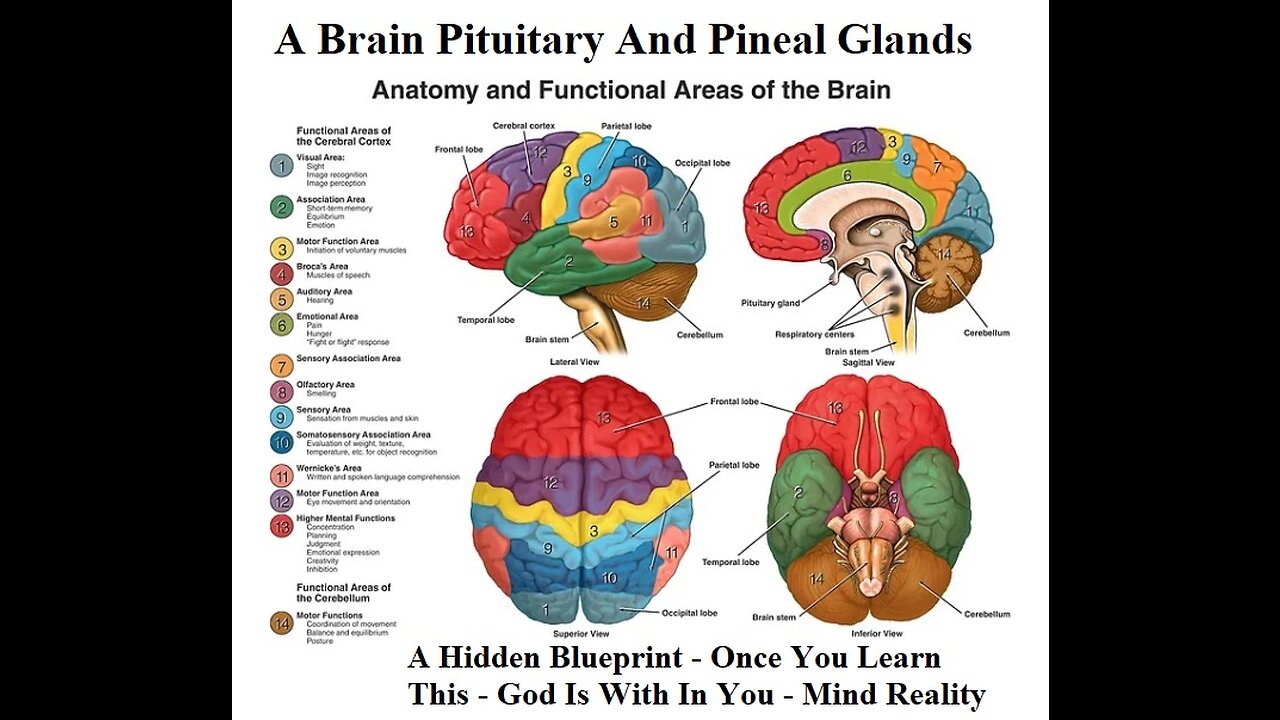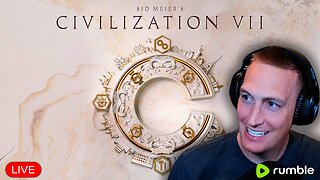Premium Only Content

Hidden Blueprint - Once You Learn This - God Is With In You - Mind Reality Changes
This is your head, your personal enclave of Heaven. Here we see God, portrayed within the structure of the brain in Michelangelo's masterpiece, reaching out to touch Adam. This space, your head, encloses your mind, the divine meeting point. The kingdom of God is within you" in response to the Pharisees' question about when the kingdom of God would come. This teaching is universal and timeless, and it means that enlightenment is within you, in your heart, and your spark of God has always been there.
Consider Genesis 32:30. Here, Jacob names a place Peniel, declaring, "I have seen God face to face." This is the pineal gland nestled in your head, a part of you that mirrors Heaven itself.
Reflect on Genesis 28:10 where Jacob speaks of a ladder, anchored to the earth, reaching up to Heaven. Look at this as your spinal cord, your own ladder extending to the Heaven within your head.
In Luke 17:20-21, Jesus said, "The kingdom of God does not come with observation; nor will they say, 'See here!' or 'See there!' For indeed, the kingdom of God is within you." This means that enlightenment is within you, in your heart, and your spark of God has always been there. The saying has numerous explanations, including that enlightenment is within you, in your heart, and your spark of God has always been there.
Your head becomes Heaven because it harbors the pineal and pituitary glands. These are the two spiritual glands, the masculine and feminine counterparts in your brain. The pineal gland has five luminescent cells on it, crystals that activate when you energize the gland. It's this pineal gland that emits light, serving as the life force for your entire body.
This is why the term 'enlightenment' is so apt, as it captures the reality of light emitting from within your mind. Consider the ancient symbol for the pineal gland, the pinecone. Here's the Sumerian God holding it, and there in the Vatican, the Pope displays it. Look at Buddha's head, crowned with the pinecone. The Egyptians, too, acknowledged the importance of this gland. It's a key, the key to other worlds.
For you to unlock these realms, you need to activate this gland. Remember that all of these religions are directing your focus outside of yourself. But your focus should be inward. That is where God resides. In you. Within your own self.
0:00 How They Hid GOD - 1:53 Your Head, Your Heaven - 5:28 The Pineal and Pituitary Glands: Doorways to Divinity - 7:15 The Pinecone Symbol: The Key to Other Worlds - 9:59 Awakening the Third Eye: The Path to Pineal Activation
https://www.yourzodiacsign.com/dates/new-13-zodiac-signs.htm
13 ZODIAC SIGNS AND THEIR DATES
Do you know that your zodiac sign is on the apparent path (the ecliptic with twelve constellations) of the Sun across the celestial sphere over the course of the year? Do you know that the Sun was above your zodiac sign when you were born? However, it was already the matter over 2000 years ago. Now, the date of zodiac signs have changed and it is no longer consistent with the astronomical phenomenon.
Due to the change of the earth's axis and the movement of solar system and stars, the current positions of zodiac signs are different with that of 2000 years ago. Since the earth's axis swings in a circle of 26000 years, the ecliptic position also changes in the sky. As a result, the time of the Sun arriving at a constellation would delay about one month every 2000 years. In addition to the twelve zodiac signs, the current ecliptic also spans the thirteenth constellation Ophiuchus which is located between Scorpio and Sagittarius. If you think you are under the Aquarius sign, you might be a Piscean while the original Scorpian might be a Sagittarian. The huge Scorpio also needs to be redesigned, perhaps only including people born on between November 23 and 29 while people born on between November 29 and December 17 should be under the Ophiuchus rather than Sagittarius sign. In 1982, the international astronomical conference modified the constellation range and approved Ophiuchus as the thirteenth onstellation. ABOUT THE 13TH ZODIAC - OPHIUCHUS
Ophiuchus in Astronomy
Ophiuchus is one of the constellations in the equatorial zone. Looking from the Earth, you will find it south of the Hercules, north of the Scorpio and Sagittarius, and west of the Milky Way. It is the only constellation which connects with another constellation Serpens, also the only one spanning celestial equator, galactic equator and ecliptic. Ophiuchus is huge and wide, just like a rectangle diagonally crossed by the celestial equator. Although it spans a very short range of the Milky Way, the center of the Milky Way is located within the Sagittarius not far from the Ophiuchus, where the Milky Way has a prominent part, forming the broadest area of the Milky Way. Ophiuchus is visible at latitudes between +80° and −80°. https://www.yourzodiacsign.com/ophiuchus/
In the 13 Moon Calendar, a calendar synchronized with the lunar phases, the 28 days of each month are divided into 4 weeks, 7 days each. The 7 days correspond to the 7 main chakras in our body, the energy moving in a spiral. They’re also called radial plasmas, an electrical fluid which activates our electromagnetic field. By being present with the sensations in our body, we can feel this flow of energy passing through us.
The pineal gland, also known as the third eye, is a light-sensing organ in some amphibians and reptiles, which regulates their circadian rhythms and senses the polarization of light. The pineal gland was originally a photoreceptor that evolved into a neuroendocrine organ. Some spiritual traditions believe it serves as a connection between the physical and spiritual worlds. The pineal gland is located deep in the center of the brain and secretes melatonin, which affects the body clock and other functions. Signs of a problem include headache and changes in menstruation. There is no scientific evidence that proves the existence of the third eye chakra.
Awakening the Third Eye is a spiritual practice that involves awakening the body of energy and activating higher states of consciousness and spiritual vision. Crystals and gemstones in the purple, indigo, and violet color palette are believed to be beneficial in awakening, balancing, aligning, and nurturing the third eye. The most common symptom of an open third eye is a growing pressure between the eyebrows, which is benign and will fade away in due time. Third Eye Awakening is a book that teaches a step-by-step method to awaken the third eye and engage spiritual vision, including techniques on clairvoyance, dowsing land energies, psychic sleep, perceiving acupuncture meridians, psychic protection, and grounding. By placing a crystal on the third eye, one can bring focus into their breath and awaken and activate the third eye. The ability to see everything shifts our perspective, so we can see our own blind spots and understand ourselves in the context of the collective.
https://www.healthline.com/health/mind-body/how-to-open-your-third-eye#how-long-does-it-take
Are third eye, concentration, and focus all interlinked?
Did you know that there is an energy center in your body that can enhance your focus, concentration, and also bring up intuitive abilities? You must have heard many spiritual people talk about awakening third eye chakra of the 7 chakras in human body and their experiences with it.
If a person is very focused on their work, then they could experience some form of third eye activation. For example, when a cricketer is very focused on their practice, when they are constantly thinking about the game and how it can be improved, they develop an intuitive sense of where the next ball is going to come. A top cricket player wouldn’t need an analyst to tell them things, they intuitively know what’s going to happen next.
Even a businessman who is extremely focused on their work, somehow knows how their client will react to a certain proposal or situation. The enhanced alpha wave emissions help them intuit what may happen in their near future, related to the field they are extremely focused on.
Let’s find out what is this phenomenon and the science behind third eye awakening or activation.
How brain waves are linked to our third eye
The third eye, to understand from a spiritual perspective, is the agya chakra or third eye chakra. There are seven energy centers in our body where nerve points meet. The agya chakra is the energy center located in the middle of our eyebrows (pineal gland). This point is associated with the ability to perceive things beyond the five senses, also called intuition.
The agya chakra is connected to the body’s pituitary and hypothalamus glands. Our brain emits different waves when it is experiencing different things:
1. Beta waves are emitted when you experience sadness, loss, stress or anguish.
2. Alpha waves are emitted when we experience calmness, relaxation, and deep joy. Alpha waves have calmer vibrations and act as sonar. Dolphins are known to possess a high level of alpha wave function in their brains and this helps them to navigate in the sea. Their sonar works similarly to a submarine. Physically, the tenderness of the pituitary and hypothalamus glands allow the alpha waves to spread.
Did you know?
In children, the pituitary and hypothalamus glands are quite tender which makes it possible for them to be more perceptive and intuitive. As we get older, the glands get stiff and some calculus gets deposited around them, the strength and frequency of the alpha wave emission diminish.
3. Gamma waves are the most powerful and can only be experienced in a deep meditative state, also known as samadhi.
Our brain emits alpha waves when the body is aligned with nature. When one is in sync with nature through their actions and thoughts, their whole being feels that it is a part of the cosmos. Because of this, nature reveals certain things to a person who is experiencing high alpha wave activity. Commonly, this is called intuition.
The experience of gamma wave emission happens in our subtle body and only when we experience regular alpha wave emissions. Gamma ray emissions activate the agya chakra. When the third eye activates, we experience a sense of lightness in our minds.
How can we experience third eye activation?
Meditation is one of the routes. Do we experience third eye activation outside of meditation? Yes!
Whenever a person is extremely focused, and if they are doing their task with utmost dedication and concentration, then their third eye activates, specifically for that aspect of their life. It also works in reverse. If a person is meditating or doing other practices to activate their third eye (pineal gland third eye), they are seen to experience increased focus and concentration in the tasks that they are dedicated to.
How to open your third eye?
The spiritual practices that help activate the third eye are:
Sudarshan Kriya taught in Art of Living’s Happiness Program
Meditation - Nadi Shodhan Pranayama - Padma sadhana
These practices relax our mind and help it get aligned with nature. As the mind calms down, the brain function improves and the alpha waves start emitting. Due to this, we experience more focus and awareness on the tasks we are doing. This continuous awareness activates the third eye.
According to Gurudev, “Too much eating, too much sleep, and too much activity is counterproductive to increase in our intuitive ability.”
People who regularly experience third eye activation feel a change in the way their breath flows. Usually, it is seen that the pace of our breathing is haphazard and it either flows from the left or right nostril. People who experience third eye activation feel that their breath is very deep and centered.
This happens quite gradually and if you feel third eye activation then you will feel that your breath is flowing very centrally.
Team leaders and people who exhibit authority experience sensations in the middle of their eyebrows. This is also associated with the agya chakra.
What are 7 chakras in the human body? How important are they for us? There are seven chakras or energy centers in the human body through which our vital energy or prana shakti flows. Sometimes, these energy channels get blocked and this leads to illness and disturbances in the body’s natural processes. It is important to understand what each chakra represents and what we can do to keep this energy flowing freely. This is possible when the chakras are balanced.
How yoga helps to balance 7 chakras in the body
When a chakra i.e. wheel of energy is stuck, movement can help release the prana (energy). Yoga postures are a great way to release stale or stuck energy from the body because they invite fresh, vital energy back in through poses and the breath.
The practice of yoga ultimately leads us to a state of union, which is possible when we create a state in our body where energy can flow freely from the base of the spine (the Root Chakra), through and beyond the top of the head (the Crown Chakra). When energy can flow freely through us like this, we can achieve a state of union with cosmic energy, which flows through all living things. When each chakra is unblocked, it spins like a wheel, hence the word ‘chakra’ meaning ‘wheel’ in Sanskrit.
Since yoga is both a physical and spiritual practice, yoga poses are not only exercises for your body but also your mind, emotions, and spirit, making it the perfect practice for balancing your chakras.
The 7 chakras in the human body
Let’s explore the seven chakras in our body, how they affect the body, what imbalance does to our personality and organs, and how to set it right by balancing the chakras with yoga asanas or poses.
1 Muladhara Chakra - 2 Swadishthana Chakra - 3 Manipura Chakra - 4 Anahata Chakra - 5 Vishuddhi Chakra - 6 Ajna Chakra - 7 Sahasrara Chakra
The pineal gland is a small endocrine gland located in the middle of the brain, beneath the back part of the corpus callosum. It secretes the hormone melatonin, which helps regulate the timing of other functions throughout the body, such as when puberty starts. The pituitary gland, located at the base of the brain, secretes hormones that regulate and control other hormone-secreting glands and many body processes, including reproduction. The pituitary gland is connected to the hypothalamus of the brain by a slender stalk called the infundibulum. The anterior pituitary secretes Thyroid stimulating hormone, Adreno-cortico trophic hormone, Growth hormone, Follicle stimulating hormone, Luteinising hormone, and Prolactin, while the posterior pituitary secretes oxytocin and vasopressin.
Difference Between Pituitary and Pineal Gland and Pituitary vs Pineal Gland
In general, there are two types of glands in our body. The first type is the duct glands that release their secretions out through the ducts into some hollow organs; like the salivary glands of the mouth and gastric glands of the stomach. The second type of glands does not have ducts, but release their secretions directly into the bloodstream, which carries the secretion to their effective place elsewhere. The second type is commonly referred to as ‘ductless glands’, and their secretions are called hormones. The main ductless glands in the body are pituitary, pineal, gonads (testicles in the male and ovaries in the female), thymus, pancreas, thyroid, parathyroid, and adrenal glands. Out of these glands, the pineal glands and pituitary glands are neuroendocrine glands, which contain neuroendocrine cells and are located in the brain. These cells are related to nerve and sensory cells, and do not release their neurotransmitters at synapses, but secrete them directly into the blood as hormones.
Pituitary Gland
Pituitary gland is located at the base of the brain posterior to the optic chiasm and is attached to the hypothalamus by a small stalk. It is known as a compound endocrine gland because of its microscopic structure. Pituitary is composed of two parts; namely, anterior pituitary and posterior pituitary. These two parts differ in many ways including their secretion hormones, embryonic origins etc. (Read more: Difference Between Anterior Pituitary and Posterior Pituitary)
The posterior pituitary gland secretes two hormones; antidiuretic hormone (ADH), which stimulates the reabsorption of water from urine, and oxytocin, which stimulates the contractions of uterus and milk ejection in the mammary glands. The anterior pituitary gland secretes seven hormones; namely, adrenocorticotropic hormone (ACTH), melanocyte- stimulating hormone (MSH), growth hormone (GH), prolactin (PRL), thyroid- stimulating hormone (TSH), luteinizing hormone (LH), and follicle- stimulating hormone (FSH).
Pineal Gland
Pineal gland is located in the roof of the third ventricle of the brain in many vertebrates. The gland is pinecone-shaped and about the size of a pea, which gives it its name. Pineal gland is evolved from a medial light- sensitive eye in primitive vertebrates. It is still present in some primitive fish and some modern reptiles. However, in other vertebrates, it is buried in the brain acting as an endocrine gland. Pineal gland secretes only the Melatonin hormone, which is a derivative of amino acid. The secretion of melatonin is regulated by the hypothalamus, and the secretion is activated in the dark. Gonds, brain, and pigment cells are the effective places of melatonin. Melatonin mainly regulates the biological rhythms by increasing its concentration in blood during night time and decreasing the same during day time. In addition, it helps to regulate reproductive cycles in some vertebrates.
What is the difference between Pituitary and Pineal Glands?
• Pituitary gland is located at the base of the brain and is attached to hypothalamus by a small stalk, whereas pineal gland is located in the roof of the third ventricle of the brain.
• Unlike the pineal gland, pituitary gland is composed of two parts.
• Pituitary gland secretes nine hormones while pineal gland secretes only one hormone.
• Pineal gland helps to regulate biological rhythms, whereas pituitary gland helps to regulate many biological processes such as growth, stimulating the secretion of other hormones, milk ejection, uterus contraction, ovulation, spermatogenesis etc.
Pituitary & Pineal Glands
Pituitary Gland
The pituitary gland or hypophysis is a small gland about 1 centimeter in diameter or the size of a pea. It is nearly surrounded by bone as it rests in the sella turcica, a depression in the sphenoid bone. The gland is connected to the hypothalamus of the brain by a slender stalk called the infundibulum.
There are two distinct regions in the gland: the anterior lobe (adenohypophysis) and the posterior lobe (neurohypophysis). The activity of the adenohypophysis is controlled by releasing hormones from the hypothalamus. The neurohypophysis is controlled by nerve stimulation.
Hormones of the Anterior Lobe (Adenohypophysis)
Growth hormone is a protein that stimulates the growth of bones, muscles, and other organs by promoting protein synthesis. This hormone drastically affects the appearance of an individual because it influences height. If there is too little growth hormone in a child, that person may become a pituitary dwarf of normal proportions but small stature. An excess of the hormone in a child results in an exaggerated bone growth, and the individual becomes exceptionally tall or a giant.
Thyroid-stimulating hormone, or thyrotropin, causes the glandular cells of the thyroid to secrete thyroid hormone. When there is a hypersecretion of thyroid-stimulating hormone, the thyroid gland enlarges and secretes too much thyroid hormone.
Adrenocorticotropic hormone reacts with receptor sites in the cortex of the adrenal gland to stimulate the secretion of cortical hormones, particularly cortisol.
Gonadotropic hormones react with receptor sites in the gonads, or ovaries and testes, to regulate the development, growth, and function of these organs.
Prolactin hormone promotes the development of glandular tissue in the female breast during pregnancy and stimulates milk production after the birth of the infant.
Hormones of the Posterior Lobe (Neurohypophysis)
Antidiuretic hormone promotes the reabsorption of water by the kidney tubules, with the result that less water is lost as urine. This mechanism conserves water for the body. Insufficient amounts of antidiuretic hormone cause excessive water loss in the urine.
Oxytocin causes contraction of the smooth muscle in the wall of the uterus. It also stimulates the ejection of milk from the lactating breast.
Pineal Gland
The pineal gland, also called pineal body or epiphysis cerebri, is a small cone-shaped structure that extends posteriorly from the third ventricle of the brain. The pineal gland consists of portions of neurons, neuroglial cells, and specialized secretory cells called pinealocytes. The pinealocytes synthesize the hormone melatonin and secrete it directly into the cerebrospinal fluid, which takes it into the blood. Melatonin affects reproductive development and daily physiologic cycles.
The pituitary gland is a small, pea-sized endocrine gland located at the base of the brain below the hypothalamus. It is attached to the hypothalamus by nerve fibers and blood vessels. The pituitary gland releases several essential hormones and controls the activity of many other hormone-secreting glands. It is sometimes called the "master" gland of the endocrine system because it controls the functions of many of the other endocrine glands. The pituitary gland is about one-half inch (1.25 cm) in diameter and rests within a hollowed-out area of the sphenoid bone called the sella turcica.
First, it helps to understand the pituitary gland.
The “master gland”: The pituitary gland is about the size of a pea. It sits at the base of the brain, roughly behind the bridge of your nose. It’s often called the “master gland” because it produces several hormones and controls other glands, such as the thyroid gland and the adrenal glands.
Part of the endocrine system: The pituitary gland is part of the endocrine system, the body’s hormone system. Hormones are natural chemicals, circulated mostly in the bloodstream, that guide everything from growth to fertility.
Anatomy: The pituitary has two parts, an anterior lobe and a posterior lobe. Each lobe releases different hormones. The pituitary gland is attached to the bottom of the hypothalamus, a part of the brain that connects the nervous system and endocrine system. The hypothalamus releases hormones, and it signals the pituitary gland to release hormones.
The pituitary gland produces many hormones that regulate bodily functions:
Adrenocorticotropic hormone: ACTH causes the adrenal glands to produce cortisol. This hormone helps your body regulate blood pressure, respond to infections, and control sugar, fat and protein.
Follicle-stimulating hormone: FSH affects reproduction, helping to release eggs in women and to make sperm in men.
Growth hormone: GH controls growth in childhood and adolescence. In adults, it maintains body structure and energy production (metabolism).
Luteinizing hormone: LH, along with FSH, helps with reproduction.
Prolactin: This hormone is involved in breast milk production (lactation).
Thyroid-stimulating hormone: TSH controls the amount of hormones produced by the thyroid gland. These hormones affect metabolism and growth.
Antidiuretic hormone: ADH helps your kidneys manage the amount of water in your body.
Oxytocin: This hormone helps control reproductive system functions, including birth and lactation.
Signs Your Third Eye Is Starting To See Although it is now known as the pineal gland, for enthusiasts of the paranormal throughout the centuries, it has been known as the third eye. The third eye is a great manifestation of psychic powers and deep insight. You may have experienced times when you felt that you could sense that something was about to occur days before it actually happened. These instances can be overwhelming if you do not know how to make heads or tails of them. Yet, you can still gain more knowledge to enrich your spiritual journey towards clarity. If you believe that your third eye might be open, but you cannot be 100% sure, you should read the below list to guarantee that you are on the right track.
1. An Increasing Pressure in Your Head
This is the most common symptom of an open third eye; you will begin to feel a growing pressure between your eyebrows. This can be just a pulse or an intense sense of something expanding in the middle of your forehead. Spiritual experts at https://www.thirdeyeparanormalsociety.com/ advise you against worrying about this, as it is completely benign and will fade away in due time. They also say that it may seemingly come out of nowhere, and that a feeling of warmth on your forehead as if someone were touching, it is fairly normal. So don’t freak out when it happens.
2. Foresight
You might experience instances of increased foresight of future events. It might just be a small tug in your stomach that alarms you that something is going to happen before it does. Do not overlook this feeling or intuition, and let it guide you forward. It might be scary at first, but the moment you realize that this power is completely controlled by you, you will have an easier time letting it show you the way.
3. Sensitivity to Light
As your third eye expands, you will find that you are more prone to light sensitivity. This is due to the fact that you are, literally, perceiving the world in a new light. You will also be able to perceive the different hues of colors in a more vivid fashion. Overall, everything related to vision and light will be heightened. You might find that polarized sunglasses help with this.
4. Gradual Changes
Because you are more in sync with your spiritual self, you will reap the benefits of your new view of the world. You will find that you are calmer, more forgiving, and loving. These changes can also impact your diet as you will steer away from processed foods to keep your third eye clear. You may not find a reason for these good changes, but rest assured that it is your intuition and spiritual powers that are guiding you to healthier life choices. Monitor these changes as they are a sure-fire way of verifying that your third eye is indeed expanding.
5. Manifestation of Powers
Contrary to popular belief, psychic powers manifesting in people who have an active third eye are not uncommon. Telepathy and clairvoyance are two of the most prominent examples of this. No matter how unfamiliar this can be to you, you must not fret. Embrace your powers and nurture them.
6. Seeing Beyond the Obvious
Although it can be a burden to know and see more than everyone does, your third eye will enable you to spot half-lies and shiny slogans. A restaurant that offers an all-you-can-eat assortment of food can be enticing to the normal individual, but for you, it will be akin to an invitation to consuming more than you need. This clarity of thought will let you make the right decisions.
7. Heightened Sense of the Self
This final sign is one that many do not even take notice of. An open third eye will increase your sense of inner self. So, instead of defining yourself as a mere person with interests, likes, and dislikes, you will instead think of yourself as a part of the fabric of the universe. This increased sense of self will enable you to rely more on yourself rather than anyone else and let you achieve the successful life you have always dreamed of having.
Experiencing the signs of an active third eye can be confusing and even downright scary if you do not know how to deal with them. Meditation and calming activities that let you have a deeper connection with your spiritual self will be your greatest asset. Regardless of the path, you will choose, always know that all of these manifestations are a blessing you should embrace, not hide.
Jesus was once asked when the kingdom of God would come. The kingdom of God, Jesus replied, is not something people will be able to see and point to. Then came these striking words: “Neither shall they say, Lo here! or, lo there! for, behold, the kingdom of God is within you.” (Luke 17:21) With these words, Jesus gave voice to a teaching that is universal and timeless.
Look into every great religious, spiritual, and wisdom tradition, and we find the same precept — that life’s ultimate truth, its ultimate treasure, lies within us.
As Jesus made unambiguously clear, we can experience this inner treasure — and no experience could be more valuable. “But seek ye first the kingdom of God and His righteousness,” he declared, “and all these things shall be added unto you” (Matthew 6:33). From this interior plane of life, he is saying, we will gain all that is needful.
Aristotle
This inner treasure of life has had many names. Plato refers to it as the Good and the Beautiful, Aristotle as Being, Plotinus as the Infinite, St. Bernard of Clairvaux as the Word, Ralph Waldo Emerson as the Oversoul. In Taoism it is called the Tao, in Judaism Ein Sof. Among Australian aborigines it is called the dreamtime, among tribes of southern Africa Hunhu/Ubuntu. The names may differ, but the inner reality they point to is one and the same.
In every case, it’s understood that this inner, transcendental reality can be directly experienced. This experience has likewise been given different names. In India traditions it is called Yoga, in Buddhism Nirvana, in Islam fana, in Christianity spiritual marriage. It is a universal teaching based on a universal reality and a universal experience.
Over the past 20 centuries, leading Christian figures have written extensively on this inner kingdom of God and their personal experience of it. Here are just a few brief excerpts from a collection of many:
St. Gregory of Nyssa (c. 335–394 • Turkey)
Gregory of Nyssa, an early Christian theologian, was one of the four great fathers of the Eastern Church and served as Bishop of Nyssa, in the center of modern-day Turkey.
[The soul] leaves all surface appearances, not only those that can be grasped by the senses but also those which the mind itself seems to see, and it keeps on going deeper until by the operation of the spirit it penetrates the invisible and incomprehensible, and it is there that it sees God. The true vision and the true knowledge of what we seek consists precisely in not seeing, in an awareness that our goal transcends all knowledge.
St. Augustine (354–430 • Algeria)
St-AugustineSt. Augustine, regarded as one of the towering intellectual geniuses in history, wrote more than a thousand works on philosophy, psychology, theology, history, political theory, and other subjects. His Confessions, from which the following passage is taken, has remained a popular and influential work for almost 1,600 years.
I entered into the innermost part of myself. . . . I entered and I saw with my soul’s eye (such as it was) an unchangeable light shining above this eye of my soul and above my mind. . . . He who knows truth knows that light, and he who knows that light knows eternity. Love knows it. O eternal truth and true love and beloved eternity!
And I often do this. I find a delight in it, and whenever I can relax from my necessary duties I have recourse to this pleasure. {I experience] a state of feeling which is quite unlike anything to which I am used — a kind of sweet delight which, if I could only remain permanently in that state, would be something not of this world, not of this life. But my sad weight makes me fall back again; I am swallowed up by normality.
St. Gregory the Great (540–604 • Italy)
St-Gregory-GreatBorn into an eminent Roman family and heir to a large fortune, Gregory decided to become a monk. After he became Pope at the age of 50, he devoted himself to social causes, the first pope especially known for doing so. He reformed the mass and introduced the ritual plainsong known today as the Gregorian chant. He was also a noted theologian. His book, Morals on Job, from which the following passage is taken, influenced religious thought for centuries.
The mind of the elect . . . is frequently carried away into the sweetness of heavenly contemplation; already it sees something of the inmost realities as it were through the mist . . . it feeds on the taste of the unencompassed Light, and being carried beyond self, disdains to sink back again into self. . . .
Sometimes the soul is admitted to some unwonted sweetness of interior relish, and is suddenly in some way refreshed when breathed on by the glowing spirit.
When this is in any way seen, the mind is absorbed in a sort of rapturous security; and carried beyond itself, as though the present life had ceased to be, it is in a way remade in a certain newness [it is refreshed in a manner by a kind of new being . . . ]. There the mind is besprinkled with the infusion of heavenly dew from an inexhaustible fountain.
Johannes Tauler (1300–1361 • France)
Johannes Tauler was one of the most influential German spiritual writers of the 1300s. Martin Luther honored Tauler as a primary influence, and Tauler has exerted a profound influence on religious thought ever since. As one scholar remarked, “Tauler presents the Christian tradition in its purest form.”
The soul has a hidden abyss, untouched by time and space, which is far superior to anything that gives life and movement to the body. Into this noble and wondrous ground, this secret realm, there descends that bliss of which we have spoken. Here the soul has its eternal abode. Here a man becomes so still and essential, so single-minded and withdrawn, so raised up in purity, and more and more removed from all things. . . . This state of the soul cannot be compared to what it has been before, for now it is granted to share in the divine life itself.
St. Teresa of Avila (1515–1582 • Spain)
St-teresa-avilaSt. Teresa was one of the greatest women of the Roman Catholic church. Her books are considered masterpieces. St. Teresa initiated the Carmelite Reform, which restored the original contemplative character of the Carmelite order. In 1970 she was Doctor of the Church — one of just 33 individuals, and the first woman, to be so honored by the Catholic church.
My soul at once becomes recollected and I enter the state of quiet or that of rapture, so that I can use none of my faculties and senses. . . .
Everything is stilled, and the soul is left in a state of great quiet and deep satisfaction.
From this recollection there sometimes springs an interior peace and quietude which is full of happiness, for the soul is in such a state that it thinks there is nothing that it lacks. Even speaking — by which I mean vocal prayer and meditation — wearies it: it would like to do nothing but love. This condition lasts for some time, and may even last for long periods.
Thomas Merton (1915–1969 • United States)
After completing a masters degree in English at Columbia University in New York, Merton entered the Abbey of Our Lady of Gethsemani, in Kentucky, as a monk. He was later ordained as a priest. He published more than 15 books of spiritual writings, poetry, fiction, and essays, and participated in movements for social justice and peace. He took great interest in the religions of the East, particularly Zen, for the light they shed on the depth of human consciousness. From the seclusion of the monastery, he exerted a worldwide influence.
In the following passage Merton describes the experience of “contemplation.” He uses the term not in the current sense (thinking intently about something) but in its older sense, to describe the experience of transcending thought:
The utter simplicity and obviousness of the infused light which contemplation pours into our soul suddenly awakens us to a new level of awareness. We enter a region which we had never even suspected, and yet it is this new world which seems familiar and obvious. The old world of our senses is now the one that seems to us strange, remote and unbelievable. . . .
A door opens in the center of our being and we seem to fall through it into immense depths which, although they are infinite, are all accessible to us; all eternity seems to have become ours in this one placid and breathless contact. . . .
You feel as if you were at last fully born.
A technique for transcending
Readers who practice the Transcendental Meditation technique will recognize in these passages clear descriptions of transcending — the natural phenomenon of mental activity settling down, like waves settling on an ocean. Consciousness reaches its most silent state, serene and unbounded. We experience pure consciousness. We realize that this is our true Self, beyond time and space, infinite and eternal.
We now know, from extensive scientific research studies, that during Transcendental Meditation practice, during the experience of transcendence, brain functioning becomes integrated, physiological activity settles down, and one experiences a unique state of restful alertness, a fourth major state of consciousness Maharishi calls Transcendental Consciousness.
Here is how Maharishi describes the technique:
Transcendental Meditation is just the simple technique of going within, and there you are! To go within is so simple; it is so natural for every man to go to a field of greater happiness. . . .
And how can it be simple? The question arises because constantly I am emphasizing its simplicity. All this message of the inner life and outer life is not new, the same age-old message of the Kingdom of Heaven within. “First seek ye the Kingdom of God and all else will be added unto you.” It is the same age-old, centuries old message, but the message emphasizes today that it is easy for everyone. Without exception, born as man, every man has the right, the legitimate right to enjoy all glories that belong to him, all glories of the inner world and all glories of the outside world. And here is a process every man can directly experience for himself.
Structure of the 13 Moon Calendar Dreamspell Calendar Explained Seven Chakras
The 13 Moon, 28-day calendar is a new standard of time for all people everywhere who desire a genuinely new world. If the calendar and time we follow is irregular, artificial and mechanized, so becomes our mind. As is our mind, so our world becomes, as is our world today: Irregular, artificial and mechanized. But if the calendar we follow is harmonic and in tune with natural cycles, so also will our mind become, and so we may return to a way of life more spiritual and in harmony with nature.
Moon and The Sacred Feminine Energy and 13 Lucky Number 13;20 Hz of Goddess
The moon represents the feminine energy, just as the sun represents the masculine. In ancient times, when the magic was still alive in the hearts of people, these celestial bodies were more than just that, they carried certain qualities and energies. The patriarchal society turned their back on the feminine energy, demonized it and turned the number 13 into an unlucky number full of superstitions, when it actually represents the number of the Goddess.
True Scriptural 13 Moon Calendar Equinox Deception of World Religions Exposed
The great end-time deception will parade under the banner of Christianity. The False Prophet will deceive the world into believing that God's true witnesses are the Beast and the False Prophet. So the Beast makes war against God's servants and kills them Revelation 11:7.
God's Calendar Vs. Man's Calendar History, Days, Months And Years Explained
When does the day really begin, from a biblical perspective? Is it at midnight, at sunrise, or at sunset? And when exactly does the week begin? On Monday, Saturday, or Sunday? Finally, when does the month and the year really begin, from a biblical perspective?
There are so many calendars today. We have the Roman calendar, the Chinese calendar, the Islamic calendar, the Hebrew calendar, and many others. Since each one is different from all the others, there’s so much confusion about this topic. So, which among them is correct?
Real First Calendar 13 months 13 zodiac signs 28 days Before The Old World Reset
The 13-month, 28-day alternative has been in use on this planet for more than 6000 years. In prehistoric India and China, and throughout South America it was the standard time-keeping system. The Essenes, Egyptians, Polynesians, Maya, Inca, Lakota, and Cherokee used a 13-month, 28-day calendar. The Celtic knowledge of the Druids is based on the Tree Calendar, also a 13-month, 28-day calendar. Today many cultures are still using their traditional 13-month calendar system.
Here's a Guide to Chakras. We're going to simplify the 7 major chakras and explain the at a practical level so that you can USE them and tap into the power of chakras for meditation, law of attraction, crystals, energy healing, aura, and more!
CHAKRA 101: ENERGY CENTERS IN BODY.
The easiest way to understand is to think of these “energy centers” like pieces of a car engine. All work together, no problems, fully working.
Some go out of balance - others have to pick up the slack. Eventually, cause problems and break down. Same thing with energy centers in your body. We’ll get into each one.
🔴 1. Root Chakra
Location = Base of Spine
Use = Survival + Security (Basic Trust)
BALANCED = Grounded, peace with survival needs/future
BLOCKED = Fear of being on streets, don’t belong in the current house or town or environment, no “home”
OVER active: greed, materialistic, money without healthy intention, prove to others
HOW TO: plants, feet on grass, outside
🟠 2. SACRAL CHAKRA
Location = Navel
Use = Creativity, Sexuality
BALANCED = JOY, pleasure, sexual charge, passion, optimism
BLOCKED = low libido, guilt, unhealthy views around sex
HOW TO: Dancing, Moonlight?
🟡 3. SOLAR PLEXUS CHAKRA
Location = Six Pack Abs
Use = Wisdom + Power
BALANCED = On purpose, will power, good self-worth
BLOCKED = low self-esteem, submissive, feeling THEM vs. ME
HOW TO: Deep breathwork
🟢 4. HEART CHAKRA
Location = Middle of chest
Use = Regulate Emotion
BALANCED = Love, love for others! unconditional, peace, empathy, acceptance, forgiveness
BLOCKED = bitter, relationship issues, trust issues, SNAPPY towards others
HOW TO: Pet animals, nature
🔵 5. THROAT CHAKRA
Location = Bottom of throat
Use = Communication
BALANCED = Good communication
BLOCKED = Secrets, withholding,
🟣 6. THIRD EYE CHAKRA
Location = Between Eyes
Use = Intuition, Inner wisdom, Visualization
BALANCED = follow heart, empath,
BLOCKED = Doubt, poor creativity, self-doubts
🟪 7. CROWN CHAKRA
Location = Top of head
Use = Spirituality, Consciousness, Oneness
https://www.shape.com/lifestyle/mind-and-body/zodiac-signs-meanings-dates
History of the 13-Month Calendar The 13-month calendar was devised by Auguste Comte in 1849. It was based on a 364-day year which included the one or two "blank" days that Abbé Mastrofini, an Italian Roman Catholic priest, had devised 15 years before. Each of the 13 months had 28 days and exactly four weeks.
This "Positivist" calendar, however, was so belabored with names of prominent men and women from ancient to modern times that it received a cold response. About the beginning of the twentieth century, the plan was revived by Moses B. Cotsworth who eliminated the superfluous names, thereby simplifying the plan. The new thirteenth month was designated "Sol."
This perpetual calendar, better known in the United States as the Eastman plan, met with favorable reception among many Americans. It was the most rational plan which they knew (before The World Calendar Association launched The World Calendar Plan at the close of 1930) and thus was endorsed by quite a number of prominent business men, statisticians and accountants. The 13-month calendar was endorsed because of its seeming simplicity and the much-desired stability. The public, however, did not take kindly to it because the changes were too drastic. A few of the changes follow:
The 13-month calendar was not easily divisible. The first quarter-year would always end with April 7 and the second quarter would begin with April 8. The half-year would begin with the 15th of the new month, Sol, and the last quarter would begin on September 22. This arrangement gave to each quarter three months and one week, or three and one-quarter months, causing fractional months. This fact alone would cause inconvenience to all activities and businesses based on quarter-years.
Another feature, looked upon with disfavor in the United States, was the change of familiar dates such as the Fourth of July, which became Sol 17. Then, too, the complete upheaval that would result from the adoption of this calendar was overwhelming in its effect. For instance, only the first 28 days of January would remain and thus be comparable with the present calendar. . . . The League of Nations eliminated [the 13-month calendar] when in 1937 the Council submitted only The World Calendar to the various nations for their opinion.
After having fought vainly for many years for the adoption of the 13-month calendar, under the able leadership of George Eastman in the United States and Moses B. Cotsworth in England, the International Fixed Calendar League, with offices in London, England, and in Rochester, New York, quietly closed its doors about 1937, and activities ceased.
-
 50:46
50:46
What If Everything You Were Taught Was A Lie?
16 days agoAmerica's True Shocking Secret Political History Great American Pt.1 Babylonian Slave Driving
2.66K8 -
 48:02
48:02
Survive History
7 hours agoCould You Survive as a Sharpshooter in the Napoleonic Wars?
129 -
 12:03
12:03
Space Ice
8 hours agoSteven Seagal's China Salesman - Mike Tyson Knocks Him Out - Worst Movie Ever
99012 -
 11:37
11:37
Degenerate Jay
8 hours agoJames Bond Needs Quality Over Quantity From Amazon
3021 -
 15:23
15:23
Misha Petrov
8 hours agoTrad Wives & Girl Bosses Go to WAR!
1.76K23 -
 2:03:11
2:03:11
TheDozenPodcast
6 hours agoFootball villain fighting the state: Joey Barton
55 -
 LIVE
LIVE
Scottish Viking Gaming
9 hours ago💚Rumble :|: Sunday Funday :|: Smash the Blerps and Vape the Terpes
885 watching -
 1:45:00
1:45:00
RG_GerkClan
11 hours ago🔴LIVE Sunday Special - It's Time for World Domination - Civilization VII - Gerk Clan
49.1K25 -
 LIVE
LIVE
Major League Fishing
4 days agoLIVE Tackle Warehouse Invitationals, Stop 1, Day 3
138 watching -
 23:34
23:34
marcushouse
11 hours ago $14.43 earnedBREAKING: Starship Launch IMMINENT – But What’s This SURPRISE Flight 9 Plan?! 🚀🔥
98.8K9